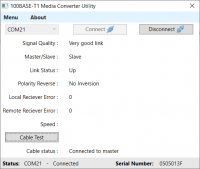
Supporting the IEEE 802.3 standard, Ethernet copper-to-fiber media converters provide connectivity for Ethernet, Fast Ethernet, Gigabit and 10 Gigabit Ethernet devices. There are a wide variety of copper-to-fiber and fiber-to-fiber media converters available that support different network protocols, data rates, cabling and connector types.

Types of Media Converters Types of Media Converters

Fiber distances can range from 300 meters to 160 kilometers, depending on the type of media converter, cable, wavelength and data rate. These characteristics have made fiber an ideal medium for commercial, utility, government and financial networks.ĭistances supported by fiber network infrastructure are limited mostly by the optical power, or brightness, supplied by the active interface hardware. Fiber has complete immunity to electrical interference, and provides higher security than copper cabling because it has no electro-magnetic emission. Media Converters Leverage the Benefits of Fiber Optic Cablingįiber can transport more data over longer distances than copper cabling, and increased distances provide the ability to reach more users and equipment. Media converters also reduce network operating costs (OPEX) by helping to troubleshoot and remotely configure network equipment that is at distant locations, saving time and money when there is not a network administrator at the distant location.
T1 MEDIA CONVERTER INSTALL
They also reduce CAPEX by avoiding the need to install new fiber links by enabling WDM technology through wavelength conversion. Media converters save capital equipment expenditures (CAPEX) by enabling interconnection between existing switches, servers, routers and hubs preserving the investment in legacy equipment. Media converters can provide all these sophisticated switch capabilities in a small, cost-effective device. These features facilitate the deployment of new data, voice and video to end users. Additionally, media converters can support advanced features including VLAN, Quality of Service (QoS) prioritization, Port Access Control and Bandwidth Control.

Media converters for Ethernet networks can support integrated switch technology, and provide the ability to perform 10/100 and 10/100/1000 rate switching. Media converters do more than convert copper-to-fiber and convert between different fiber types.

They support a wide variety of protocols, data rates and media types to create a more reliable and cost-effective network. Media converters provide seamless integration of copper and fiber, and different fiber types in Enterprise LAN networks. Media converters present solutions to these problems, by allowing the use of fiber when it is needed, and integrating new equipment into existing cabling infrastructure. Network complexity, demanding applications, and the growing number of devices on the network are driving network speeds and bandwidth requirements higher and forcing longer distance requirements within the Local Area Network (LAN). Media converters can also convert between wavelengths for Wavelength Division Multiplexing (WDM) applications.ĭeployed in Enterprise, Government, Data Center, and Telecom Fiber to the x networks, media converters have become the Swiss army knife of networking to enable connectivity and fiber distance extension. Media converters are typically protocol specific and are available to support a wide variety of network types and data rates. Media converters are available as Physical Layer or Layer 2 switching devices, and can provide rate-switching and other advanced switching features like VLAN tagging. Copper-to-fiber conversion using media converters enables two network devices with copper ports to be connected over extended distances via fiber optic cabling. The most common type of media converter is a device that functions as a transceiver converting the electrical signal used in copper Unshielded Twisted Pair (UTP) network cabling into light waves used in fiber optic cabling.įiber optic connectivity is necessary when the distance between two network devices exceeds the transmission distance of copper cabling. Media converters are flexible and cost-effective devices for implementing and optimizing fiber links in all types of networks. Media Converter Overview What is a Media Converter?


 0 kommentar(er)
0 kommentar(er)
